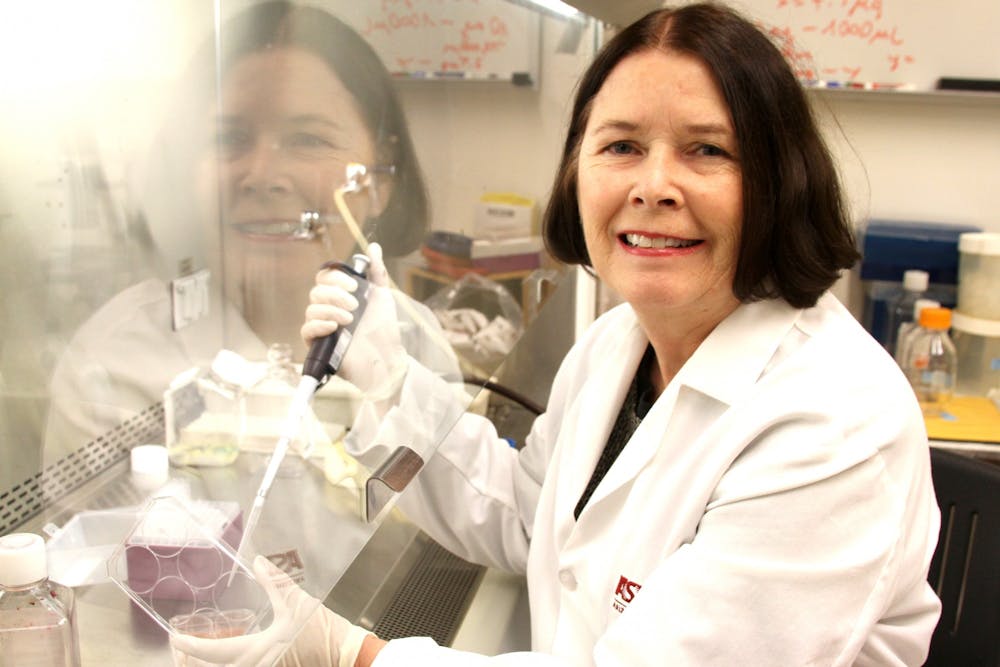Brenda Hogue has been bombarded with a seemingly constant stream of phone calls and emails lately.
With an outbreak of the new coronavirus, or COVID-19, Hogue’s work as a professor at the Biodesign Center for Immunotherapy, Vaccines and Virotherapy has become very popular. She specializes in researching coronaviruses and influenza.
Hogue synthesizes RNA, or ribonucleic acid, from the genomes of viruses in an effort to find a vaccine. RNA typically acts as a messenger for DNA, sending signals that act as instructions. In some viruses, including COVID-19, RNA contains the genetic material that allows Hogue to create a molecule.
Synthesizing molecules for vaccines
Hogue said the open communication between scientists across the globe relating to COVID-19 allowed her to begin researching quickly.
Coronaviruses are generally transferred from animals to humans with an intermediate host animal as the origin of contagion, according to Hogue. Hogue said researchers are currently not sure what COVID-19's intermediate host was.
"Based on the genetic information, you take the genome of these different viruses and you compare them to other known coronaviruses," Hogue said. "It appears that most of these viruses have actually moved from bats."
Hogue said researchers suspect the new virus can spread more easily than SARS. Hogue said research on severe acute respiratory syndrome found that some individuals, called "super spreaders," were responsible for multiple infections. No super spreader cases have been confirmed for COVID-19, she said.
The previous work from other outbreaks and the real-time availability of current research happening in China have helped Hogue work with COVID-19.
“We've taken some of our work previously when SARS appeared and we did do some work on vaccine development for SARS,” Hogue said. “So our basic studies actually helped to inform what we should actually be focusing on for vaccine development.”
Hogue uses the genome released by other researchers to synthesize a noninfectious replica of the virus. She then examines how it interacts with host cells. Hogue uses mammalian cells from various sources including mice, monkeys and some human samples.
Understanding the structure and function of the virus molecules is key to vaccine development, Hogue said. With this information, she can learn how the virus infects a host and how a vaccine would interact with it.
Hogue's work is closely paid attention to as people continue to have concerns about the virus. Recently, ASU canceled a study abroad trip to South Korea as CDC officials frequently update their assessment of the outbreak.
Lab safety is always a concern for scientists, but when working with infectious diseases, extra precautions must be taken. Hogue said when she is working with the synthetic virus molecules, she works in a Biosafety Level 3 lab.
Hogue is waiting to be able to get samples of the real virus. When she receives those she will move to a Biosafety Level 4 lab, which is the highest rating on the scale. These labs are specially designed to accommodate extra precautions and researchers must wear special clothing and respirators to protect themselves from the virus.
Bioinformatics and disease tracking
A few floors down from Hogue, Matthew Scotch is studying infectious diseases from another angle. Scotch and his fellow investigators are using wastewater samples in an effort to track viruses.
Scotch's background is in data science and bioinformatics. He is not specifically focusing on COVID-19, but he thinks his methods could help track similar future outbreaks.
Scotch is working to compare wastewater samples collected from several U.S. cities and collection sites in Tempe. Scotch said they collect some samples from the wastewater systems at ASU Health Services.
Scotch uses the data collected from these samples and looks at data relating to viruses to attempt to identify concentrations of infections.
"What we try to do is manage and aggregate that data," Scotch said. "Then using different approaches, one called phylodynamics, (we) basically study how the virus has evolved and spread and what implications that means for epidemics and outbreaks."
Scotch said his research aims to improve the system in which outbreaks of new viruses and influenza are identified. He said that if a doctor found a case for a very serious disease like ebola, they would certainly act, but not always.
"You're going to tell the CDC and health department," Scotch said. "But for a lot of these other things, where we have known epidemics like flu, you might not have the same response."
Scotch said because patients can be asymptomatic or reluctant about seeking care, this method can help detect outbreaks faster. The researchers have also detected viruses that they cannot recognize, Scotch said.
Erin Driver works with the team collecting samples of wastewater. She said they mainly collect samples from water treatment plants.
She said small machines in sewage systems collect samples periodically in glass jars.
Driver said that the samples are collected based on time intervals and the amount of water flowing past the machine. She said with this method they can collect an accurate sample reflecting the region.
"We take the 24 composites because we want kind of a representative sample of what's happening," Driver said.
Driver screens the sample for opioid chemicals as part of another project before sending it on to Scotch's investigators to screen for viruses.
"Part of it is looking at flu but then they're also looking at kind of novel viruses, like things that no one really knows," Driver said.
Hogue said the increased media attention when outbreaks happen can be ultimately positive.
"I think that that people in general are just interested in science," Hogue said. "Things like this help to remind them of some of the realities of what we deal with for infectious diseases."
Reach the reporter at gmlieber@asu.edu or follow @G_Mira_ on Twitter.
Like The State Press on Facebook and follow @statepress on Twitter.




